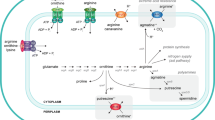Abstract
The hypusine-containing protein (Hypp) is highly conserved in evolution, from man to archaebacteria, but is not found in eubacteria. Hypp is essential for the viability for yeast cells, where two forms are encoded by the genes HYP1 and HYP2. The hypusine-containing protein Hyp2p, encoded by the HYP2 gene in yeast, is present under both aerobic and anaerobic conditions, whereas Hyp1p synthesis is restricted to anaerobiosis. hyp1 disruption mutants grown under anaerobic conditions reveal no detectable alteration in phenotype relative to wild-type strains. We demonstrate that either Hyp1p or Hyp2p alone is sufficient for normal growth under both metabolic conditions. Moreover, Hypp from various eukaryotic species (slime mold, alfalfa and man) carries the lysine to hypusine modification when expressed in yeast and can substitute functionally for Hyp2p in strains disrupted for HYP2, indicating a highly conserved function of this protein. In contrast, the archaebacterial Hypp expressed in yeast is neither modified by hypusine, nor does it allow growth of cells deficient for yeast Hypp.
Similar content being viewed by others
References
Bartig D, Lemkemeier K, Frank J, Lottspeich F, Klink F (1992) The archaebacterial hypusine-containing protein. Structural features suggest common ancestry with eukaryotic translation initiation factor 5A. Eur J Biochem 204: 751–758
Boeke JD, Truehart J, Natsoulis G, Fink GR (1987) 5-Fluoroorotic acid as a selective agent in yeast molecular genetics. Methods Enzymol 154: 164–175
Cooper HL, Park MH, Folk JE, Safer B, Braverman R (1983) Identification of the hypusine-containing protein Hy+ as translation initiation factor eIF-4D. Proc Natl Acad Sci USA 80: 1854–1857
Kand AK, Schwelberger HG, Hershey JWB (1992) The two genes encoding protein synthesis initiation factor eIF-5A in Saccharomyces cerevisiae are members of a duplicated gene cluster. Mol Gen Genet 233: 487–490
Kang AK, Schwelberger HG, Hershey JWB (1993) Effect of initiation factor eIF-5A depletion on cell proliferation and protein synthesis. In: Brown AJP, Tuite MF, McCarthy JEG (eds) Protein synthesis and targeting in yeast. NATO ASI Series H vol 71. Springer-Verlag, Berlin
Klebe RJ, Harris JV, Sharp ZD, Douglas MG (1983) A general method for polyethylene glycol-induced genetic transformation of bacteria and yeast. Gene 25: 333–341
Klier H, Lottspeich F (1992) Detection of the hypusine-containing protein (HP = eIF-5A) in crude yeast extracts by two-dimensional Western blots. Electrophoresis 13: 732–735
Klier H, Wöhl T, Eckerskorn C, Magdolen V, Lottspeich F (1993) Determination and mutational analysis of the phosphorylation site in the hypusine-containing protein Hyp2p. FEBS Lett 334: 360–364
Lowry CV, Weiss JL, Walthall DA, Zitomer RS (1983) Modulator sequences mediate oxygen regulation of CYC1 and a neighboring gene in yeast. Proc Natl Acad Sci USA 80: 151–155
Magdolen V, Drubin DG, Mages G, Bandlow W (1993) High levels of profilin suppress the lethality caused by overproduction of actin in yeast cells. FEBS Lett 316: 41–47
Mehta KD, Leung D, Lefebvre L, Smith M (1990) The ANB1 locus of Saccharomyces cerevisiae encodes the protein synthesis initiation factor eIF-4D. J Biol Chem 265: 8802–8807
Moracci M, La Volpe A, Pulitzer JF, Rossi M, Ciaramella M (1992) Expression of the thermostable β-galactosidase gene from the archaebacterium Sulfolobus solfataricus in Saccharomyces cerevisiae and characterization of a new inducible promoter for heterologous expression. J. Bacteriol 174: 873–882
Park MH, Wolff EC, Folk JE (1993) Hypusine: its post-translational formation in eukaryotic initiation factor 5A and its potential role in cellular regulation. Biofactors 4: 95–104
Pay A, Heberle-Bors E, Hirt H (1991) Isolation and sequence determination of the plant homologue of the eukaryotic initiation factor 4D cDNA from alfalfa, Medicago sativa. Plant Mol Biol 17: 927–929
Rothstein RJ (1983) One-step gene disruption in yeast. Methods Enzymol 101: 202–211
Sambrook J, Fritsch EF, Maniatis T (1989) Molecular cloning: a laboratory manual, 2nd edn. Cold Spring Harbor Laboratory Press, Cold Spring Harbor, New York
Sandholzer U, Centea-Intemann M, Noegel AA, Lottspeich F (1989) cDNA and derived amino acid sequence of the hypusine-containing protein from Dictyostelium discoideum. FEBS Lett 246: 94–100
Schnier J, Schwelberger HG, Smit-McBride Z, Kang HA, Hershey JWB (1991) Translation initiation factor 5A and its hypusine modification are essential for cell viability in the yeast Saccharomyces cerevisiae. Mol Cell Biol 11: 3105–3114
Schwelberger HG, Kang HA, Hershey JWB (1993) Translation initiation factor eIF-5A expressed from either of two yeast genes or from human cDNA. J Biol Chem 268: 14018–14025
Sherman F, Fink GR, Hicks JB (1986) Methods in yeast genetics: a laboratory manual, revised edn. Cold Spring Harbor Laboratory Press, Cold Spring Harbor, New York
Smit-McBride Z, Schnier J, Kaufman RJ, Hershey JWB (1989) Protein synthesis initiation factor eIF-4D. J Biol Chem 264: 18527–18530
Wöhl T, Baur M, Fredl AA, Lottspeich F (1992) Chromosomal localization of the HYP2 gene in Saccharomyces cerevisiae and use of pulsed-field gel electrophoresis for detection of irregular recombination events in gene disruption experiments. Electrophoresis 13: 651–653
Wöhl T, Klier H, Ammer H, Lottspeich F, Magdolen V (1993) The HYP2 gene of Saccharomyces cerevisiae is essential for aerobic growth: characterization of different isoforms of the hypusinecontaining protein Hyp2p and analysis of gene disruption mutants. Mol Gen Genet 241: 305–311
Zitomer RS, Lowry CV (1992) Regulation of gene expression by oxygen in Saccharomyces cerevisiae. Microbiol Rev 56: 1–11
Author information
Authors and Affiliations
Additional information
Communicated by C. P. Hollenberg
Rights and permissions
About this article
Cite this article
Magdolen, V., Klier, H., Wöhl, T. et al. The function of the hypusine-containing proteins of yeast and other eukaryotes is well conserved. Molec. Gen. Genet. 244, 646–652 (1994). https://doi.org/10.1007/BF00282755
Received:
Accepted:
Issue Date:
DOI: https://doi.org/10.1007/BF00282755




